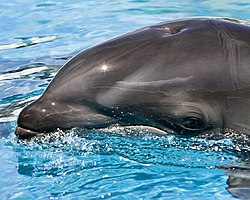Wholphin: Difference between revisions
mNo edit summary |
Cited Reference to Wholphin being known as "The Great Grey Beast" in a book and added the information. |
||
| Line 29: | Line 29: | ||
</ref> Although they have been reported to exist in the wild,<ref name=msnbc/> there are currently only two in captivity, both at [[Sea Life Park]] in [[Hawaii]].<ref name=sean>{{cite news |author=[[Sean B. Carroll]] |coauthors= |title=Remarkable creatures |url=http://www.nytimes.com/2010/09/14/science/14creatures.html?src=me&ref=general |quote=The first captive wholphin, Kekaimalu, was born on May 15, 1985, to a female bottlenose dolphin named Punahele, who shared a pool with a male false killer whale named Tanui Hahai. The wholphin's size, color and shape are intermediate between the parent species. She has 66 teeth - intermediate between a bottlenose (88 teeth) and false killer whale (44 teeth). |
</ref> Although they have been reported to exist in the wild,<ref name=msnbc/> there are currently only two in captivity, both at [[Sea Life Park]] in [[Hawaii]].<ref name=sean>{{cite news |author=[[Sean B. Carroll]] |coauthors= |title=Remarkable creatures |url=http://www.nytimes.com/2010/09/14/science/14creatures.html?src=me&ref=general |quote=The first captive wholphin, Kekaimalu, was born on May 15, 1985, to a female bottlenose dolphin named Punahele, who shared a pool with a male false killer whale named Tanui Hahai. The wholphin's size, color and shape are intermediate between the parent species. She has 66 teeth - intermediate between a bottlenose (88 teeth) and false killer whale (44 teeth). |
||
|work=[[New York Times]] |date=September 13, 2010 |accessdate=2010-09-14 }}</ref> |
|work=[[New York Times]] |date=September 13, 2010 |accessdate=2010-09-14 }}</ref> |
||
Wholphins, though not commonly sighted by fisherman, are known in popular seafaring lore as "The Great Gray Beast." |
|||
{{cite web |
|||
|url=http://books.google.com/books?id=g5bOW53uOiwC&pg=PA215&lpg=PA215&dq=wholphin+%22the+great+gray+beast%22&source=bl&ots=5C5IK9AbF1&sig=5u_-L_cHII-xuyDLEOZ8bPz6ui4&hl=en&sa=X&ei=myDtTpnBL6ylsALBrNDbCQ&ved=0CB0Q6AEwAA#v=onepage&q=wholphin%20%22the%20great%20gray%20beast%22&f=false |
|||
|title=Beyond Bizarre: Frightening Facts and Blood-Curdling True Tales |
|||
|publisher=[[Red Wheel/Weiser]] |
|||
|accessdate=20011-12-17 |
|||
|date=2010 |
|||
}} |
|||
Kekaimalu, the first wholphin in captivity, proved fertile when she gave birth at a very young age. The calf died after a few days. However, in 1991, Kekaimalu gave birth once again, to daughter Pohaikealoha. For 2 years she cared for the calf, but did not nurse it (it was hand-reared by trainers). Pohaikealoha died at age 9. |
Kekaimalu, the first wholphin in captivity, proved fertile when she gave birth at a very young age. The calf died after a few days. However, in 1991, Kekaimalu gave birth once again, to daughter Pohaikealoha. For 2 years she cared for the calf, but did not nurse it (it was hand-reared by trainers). Pohaikealoha died at age 9. |
||
Revision as of 23:19, 17 December 2011
| Wholphin | |
|---|---|

| |
| Kawili Kai, born to a female wholphin by a male dolphin, at 9 months of age in September 2005 | |
| Scientific classification | |
| Kingdom: | |
| Phylum: | |
| Class: | |
| Order: | |
| Family: | |
| Genus: | |
| Species: | |
| Binomial name | |
| none | |
A Wholphin or Wolphin is a rare hybrid, born from a mating of a female Bottlenose Dolphin (Tursiops truncatus) with a male false killer whale (Pseudorca crassidens). The name implies a hybrid of whale and dolphin, although taxonomically, both are within the "oceanic dolphin" family, which is within the "toothed whale" suborder.[1][2] Although they have been reported to exist in the wild,[2] there are currently only two in captivity, both at Sea Life Park in Hawaii.[1]
Wholphins, though not commonly sighted by fisherman, are known in popular seafaring lore as "The Great Gray Beast."
"Beyond Bizarre: Frightening Facts and Blood-Curdling True Tales". Red Wheel/Weiser. 2010. Retrieved 20011-12-17. {{cite web}}: Check date values in: |accessdate= (help)
Kekaimalu, the first wholphin in captivity, proved fertile when she gave birth at a very young age. The calf died after a few days. However, in 1991, Kekaimalu gave birth once again, to daughter Pohaikealoha. For 2 years she cared for the calf, but did not nurse it (it was hand-reared by trainers). Pohaikealoha died at age 9.
On December 23, 2004, Kekaimalu had her third calf, daughter Kawili Kai, sired by a male bottlenose. This calf did nurse and was very playful. Only months after birth, it was the size of a 1-year-old bottlenose dolphin.[1]
Both remain in captivity, and are now part of the normal tour at Sea Life Park in Hawaii, USA. Kekaimalu is featured in the main dolphin show at Sea Life Park.
References
- ^ a b c Sean B. Carroll (September 13, 2010). "Remarkable creatures". New York Times. Retrieved 2010-09-14.
The first captive wholphin, Kekaimalu, was born on May 15, 1985, to a female bottlenose dolphin named Punahele, who shared a pool with a male false killer whale named Tanui Hahai. The wholphin's size, color and shape are intermediate between the parent species. She has 66 teeth - intermediate between a bottlenose (88 teeth) and false killer whale (44 teeth).
{{cite news}}: Cite has empty unknown parameter:|coauthors=(help) - ^ a b "Whale-dolphin hybrid has baby wholphin". MSNBC. April 15, 2005. Retrieved 2009-11-12.
External links
- Waimanalo Hapa Girl Makes 10!, by Keene Rees
- A 'Wholphin' Is Born at CBS News

